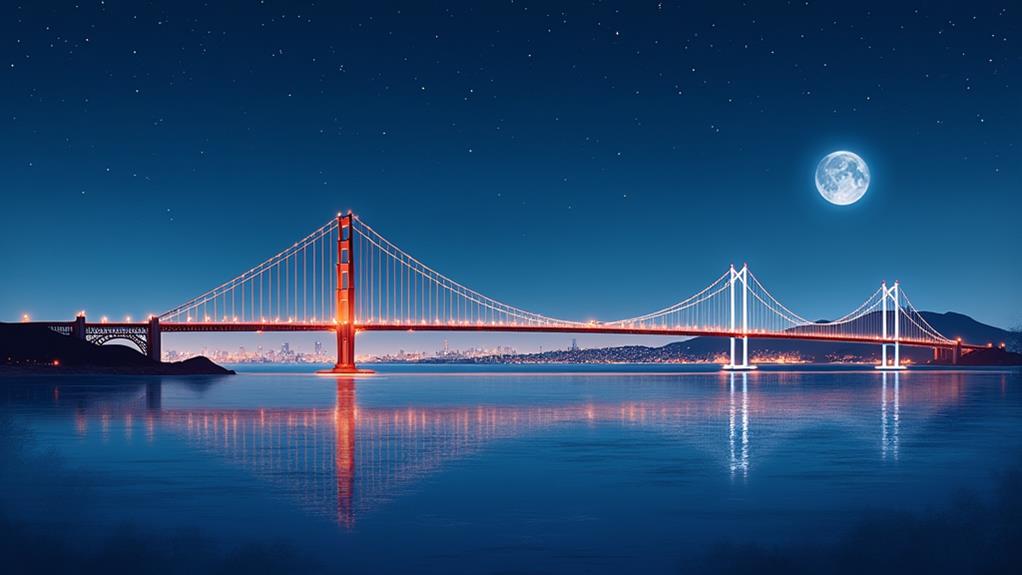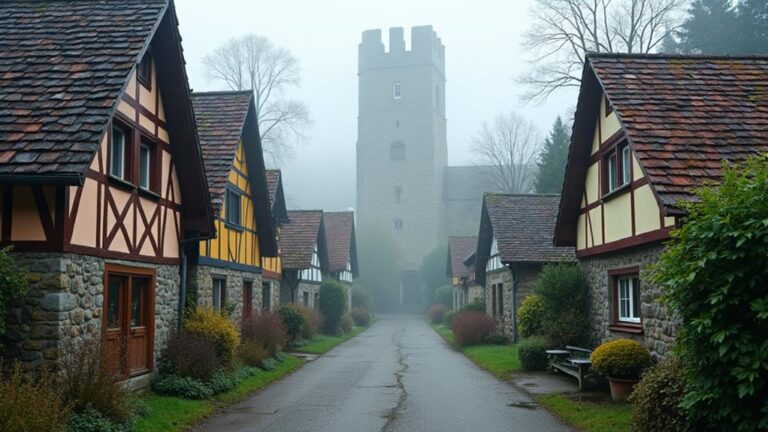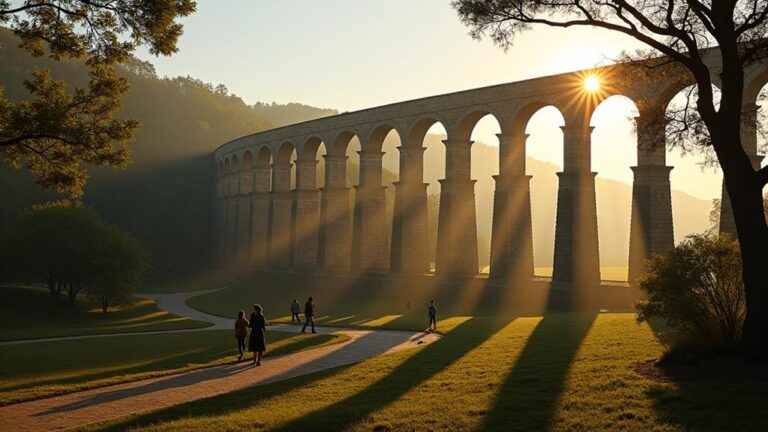You've likely seen images of the world's most famous bridges, but do you know the stories behind these iconic structures? The Golden Gate Bridge, Sydney Harbour Bridge, and Tower Bridge are just a few examples of engineering marvels that have become synonymous with their respective cities. As you explore these bridges, you'll discover they're not just feats of engineering, but also breathtaking works of art that have become deeply ingrained in our cultural heritage. But what makes these bridges so remarkable, and which others deserve a place alongside them among the world's most famous?
Contents
Key Takeaways
- The Golden Gate Bridge is a iconic symbol of American engineering and innovation, spanning 1.7 miles across San Francisco Bay.
- Europe is home to numerous historic bridges, such as the Pont du Gard and Rialto Bridge, showcasing innovative designs.
- The Sydney Harbour Bridge is a hybrid design that combines a cantilevered arch with a suspended-deck structure, featuring a central span of 503 meters.
- Ancient Roman bridges, such as the Alcántara Bridge, used stone, concrete, and arches to create robust structures that still stand today.
- Famous bridges like Tower Bridge and the Golden Gate Bridge are engineering marvels that have become synonymous with their respective cities.
Golden Gate Bridge Overview
Crossing the San Francisco Bay in California, the Golden Gate Bridge is a Suspension bridge that connects the city of San Francisco to Marin County, spanning a total length of 1.7 miles (2.7 kilometers).
You'll notice the bridge's art deco design and striking orange color, which has become an iconic symbol of the city.
As you explore into Golden Gate facts, you'll learn that the bridge's construction was completed in 1937, with a total cost of $35 million.
The bridge's design was led by architect Irving Morrow, who chose the distinctive orange color, known as "International Orange," to make the bridge more visible in the foggy San Francisco climate.
The Golden Gate Bridge has become a powerful symbol of American engineering and innovation, representing the country's ability to achieve grand feats.
As a result, the bridge has become a popular tourist destination, attracting millions of visitors each year.
Bridge symbolism is also evident in the bridge's design, with the two towers representing the connection between the city and the natural world.
You'll appreciate the bridge's technical and historical significance as you explore its many facets.
Famous Bridges in Europe
As you explore famous bridges in Europe, you'll encounter iconic landmarks that have shaped the continent's architectural heritage.
The region is home to numerous historic bridges, such as the Pont du Gard in France and the Rialto Bridge in Italy, which showcase innovative designs that have withstood the test of time.
Iconic European Landmarks
Located at the intersection of engineering, history, and culture, Europe's iconic bridges are awe-inspiring monuments to human ingenuity.
As you explore the continent, you'll find that many of these bridges aren't just functional river crossings, but also integral parts of European culture.
They've been built to withstand the test of time, harsh weather conditions, and heavy usage.
From the Pont du Gard in France to the Charles Bridge in the Czech Republic, iconic European landmarks showcase the region's rich history and engineering prowess.
You'll notice that many of these bridges have become synonymous with their respective cities, reflecting the unique cultural heritage of each location.
The architecture of these bridges varies greatly, from the ornate details of the Ponte Vecchio in Italy to the sleek, modern design of the Erasmusbrug in the Netherlands.
As you analyze these iconic bridges, you'll appreciate the technical expertise and innovative solutions that have gone into their construction.
Historic Bridge Designs
Europe's historic bridge designs showcase a range of innovative solutions born from the convergence of engineering ingenuity, cultural influences, and environmental challenges.
As you explore these structures, you'll notice the Arch Bridge Evolution, which involved the development of semicircular and segmental arches, enabling longer spans and greater structural integrity.
This, in turn, allowed for the construction of more complex and iconic bridges.
Some notable examples of historic bridge designs in Europe include:
- The Pont du Gard in France, a Roman aqueduct bridge featuring a three-tiered arch system
- The Charles Bridge in Prague, Czech Republic, a medieval stone bridge with a Gothic design
- The Tower Bridge in London, UK, a Victorian-era bascule bridge with a suspension system
- The Ponte Vecchio in Florence, Italy, a medieval stone bridge with a series of shops and merchants' houses
Suspension Innovations also played a significant role in the development of European bridges.
The introduction of chains and cables enabled longer spans and lighter structures, paving the way for modern suspension bridges.
Sydney Harbour Bridge
As you examine the Sydney Harbour Bridge, you'll notice its hybrid design, which combines a cantilevered arch with a suspended-deck structure,
features a central span of 503 meters and a maximum height of 134 meters.
Constructed by Dorman Long and Co. between 1926 and 1932, the bridge showcases the innovative engineering solutions of its time.
Analyzing its design and construction reveals an engineering marvel that has become an iconic Australian landmark.
Design and Construction
When you explore into the design and construction of the Sydney Harbour Bridge, you're looking at a masterpiece that has stood the test of time.
As you dig deeper into its engineering, you'll discover the intricate details that make it a marvel of modern architecture.
The Sydney Harbour Bridge is a steel arch bridge with a hybrid cable-stayed and suspension design, showcasing the innovative use of cable systems and suspension techniques.
Some of the notable design and construction features of the Sydney Harbour Bridge include:
- The bridge's arch is composed of two steel halves, each with a 503-foot radius, that are pinned together at the center, creating a sturdy structure.
- The suspension system is comprised of four main cables, each measuring 1,188 feet long and weighing over 7,000 tons, that are anchored to the bridge's abutments.
- The bridge's roadway is suspended 141 feet above the water, providing ample clearance for maritime traffic.
- The construction process utilized a unique technique called the "creeper crane," which allowed workers to build the bridge's arches from the inside out.
Iconic Australian Landmark
The Sydney Harbour Bridge's iconic status is deeply rooted in Australia's cultural heritage.
As you examine its impact on Australian culture, you notice the bridge's presence in various forms of art, literature, and film. It's often depicted as a symbol of Sydney, and its image is synonymous with Australian identity.
The bridge's status as a cultural icon is reinforced by its proximity to the Sydney Opera House, its famous neighbour.
As you analyze the bridge's cultural significance, you observe that it has been the backdrop for numerous events, including New Year's Eve fireworks displays and the Sydney Mardi Gras parade.
These events showcase the bridge's ability to bring people together, fostering a sense of community and national pride.
The bridge's design, which combines functionality with aesthetics, has also contributed to its iconic status.
You see that its steel arches and Gothic-inspired towers have been meticulously crafted to create a sense of grandeur, making it a beloved landmark in Australian culture.
The bridge's enduring presence has cemented its place in Australia's collective consciousness.
Engineering Marvel
Standing at the forefront of engineering innovation in the 1930s, Sydney Harbour Bridge's construction pushed the boundaries of what was thought possible at the time.
As you explore into the bridge's design, you'll discover a complex system of interconnected components that work harmoniously to support its massive structure.
Key features of the Sydney Harbour Bridge's engineering marvel include:
- Cable systems: The bridge's steel cables are anchored to the towers and the road deck, providing the necessary tensile strength to support the bridge's massive loads. These cables are arranged in a series of suspender cables, which connect to the road deck, and main cables, which connect to the towers.
- Structural analysis: Advanced structural analysis techniques were used to design the bridge's framework, ensuring that it could withstand strong winds, earthquakes, and heavy loads. The bridge's arched shape allows it to distribute loads evenly, reducing stress concentrations.
- Precise calculations: Engineers used precise calculations to determine the ideal shape and size of the bridge's components, including the towers, cables, and road deck.
- Innovative construction techniques: The bridge's construction required innovative techniques, such as the use of a "creeper crane" to lift the steel components into place.
Bridges of Ancient Rome
Many of Ancient Rome's approximately 1,000 bridges, constructed throughout its vast territories, played pivotal roles in facilitating trade, communication, and military conquests.
You see these structures as integral components of Ancient Rome's infrastructure, with some bridges still standing today.
The Romans' innovative engineering techniques enabled them to build bridges that could withstand harsh weather conditions and last for centuries.
As you analyze Ancient Rome's bridges, you'll notice their designs often incorporated Roman aqueducts.
The combination of these two structures allowed the Romans to efficiently distribute water across their territories.
For instance, the Alcántara Bridge, which spans the Tagus River in Spain, still features an intact Roman aqueduct.
This seamless integration of bridges and aqueducts showcases the Romans' mastery of ancient infrastructure.
The Romans' bridge-building techniques also involved using stone, concrete, and arches to create robust structures.
Their use of arches, in particular, enabled them to construct longer bridges that could withstand external forces like floods and earthquakes.
Tower Bridge in London
You're now looking at one of London's most iconic landmarks, Tower Bridge, a masterpiece of Victorian engineering that has been fascinating visitors since its completion in 1894.
This London Icon spans the River Thames, connecting the north and south banks of the river. Tower Bridge's design is a legacy to the ingenuity of its architects, John Wolfe Barry and Horace Jones.
The bridge's structure consists of two towers, each 65 meters tall, which are connected by a central lift span that can be raised to allow large ships to pass underneath.
Some notable features of Tower Bridge include:
- The bridge's framework is made of over 11,000 tons of steel, with a combined length of over 71,000 meters.
- The central lift span is counterbalanced by two massive weights, each weighing over 1,000 tons.
- The bridge is painted with over 60 tons of paint every 25 years to protect it from the elements.
- The bridge's towers are clad in Cornish granite and limestone, with a unique brickwork pattern that adds to its aesthetic appeal.
San Francisco's Iconic Span
As you cross from one coast to another, the Golden Gate Bridge becomes a quintessential symbol of American engineering prowess, exemplifying the ingenuity and innovative spirit of the early 20th century.
Designed by engineer Joseph Strauss, architect Irving Morrow, and engineer Leon Moisseiff, the Golden Gate Bridge is a masterclass in suspension bridge design, featuring two 746-foot tall towers that support the main span.
On foggy mornings, the bridge's art deco aesthetic is shrouded in mist, adding to its mystique.
The bridge's construction was no easy feat, with workers facing treacherous conditions and strong tidal currents.
Completed in 1937, the Golden Gate Bridge was the longest suspension bridge at the time, spanning 4,200 feet.
Its design also accommodated the needs of the US Navy, allowing large ships to pass beneath the bridge.
Today, the Golden Gate Bridge is a popular destination for bay exploration, offering breathtaking views of the San Francisco Bay and the city's iconic skyline.
As you explore the bridge, you'll appreciate the intricate details of its design, from the iconic orange paint to the precise engineering that has made it an enduring symbol of American ingenuity.
World's Longest Bridges
China's longest bridge, the Danyang-Kunshan Grand Bridge, holds the Guinness World Record for the longest bridge in the world, spanning an impressive 164.8 kilometers.
As you explore the world of engineering marvels, you'll find that this bridge is an epitome to human ingenuity and technological advancements.
When it comes to record-breaking bridges, you'll notice that many of them are either cable stayed bridges or suspension bridges.
These designs allow for longer spans and more efficient use of materials.
*Danyang-Kunshan Grand Bridge, China*: 164.8 km, a high-speed rail bridge that showcases China's engineering prowess
*Tianjin Grand Bridge, China*: 113.7 km, a high-speed rail bridge that features a cable stayed design
*Lake Pontchartrain Causeway, USA*: 38.6 km, a highway bridge that holds the record for the longest bridge over water
*Manchac Swamp Bridge, USA*: 36.7 km, a highway bridge that spans a vast wetland area
These bridges have set new suspension records and pushed the boundaries of engineering design.
As you examine more closely into the world of famous bridges, you'll discover more marvels of modern engineering.
Brooklyn Bridge History
From marvels of modern engineering to historical landmarks, famous bridges have always captivated human imagination. When you think of iconic bridges, the Brooklyn Bridge is one of the first that comes to mind.
As you explore into the Brooklyn Bridge history, you'll discover that it was a game-changer for New York City. Completed in 1883, the Brooklyn Bridge was the longest suspension bridge in the world at that time, spanning 1,595.5 feet across the East River.
The Brooklyn Bridge's construction played a significant role in Brooklyn's revival, connecting the then-independent city to Manhattan and transforming it into a thriving borough.
You'll notice that the bridge's design, engineered by John A. Roebling and his son Washington Roebling, features a hybrid cable-stayed/suspension system, which was innovative for its time.
The Brooklyn Bridge has become an integral part of NYC iconography, symbolizing the city's resilience and growth. As you analyze the bridge's history, you'll appreciate its technical and historical significance, as well as its enduring impact on New York City's development and identity.
Frequently Asked Questions
How Do Bridges Withstand Strong Winds and Earthquakes?
You design bridges to withstand strong winds and earthquakes by incorporating wind resistance and seismic design principles, using aerodynamic shapes and flexible materials to dissipate forces, ensuring structural integrity and minimizing damage from turbulent air and seismic activity.
Who Maintains the World's Most Famous Bridges?
You oversee bridge maintenance by scheduling regular inspections, allocating funds for repairs, and managing maintenance costs to guarantee structural integrity and extend lifespan, often working with government agencies and private contractors to prioritize tasks.
Can Bridges Be Built Underwater for Better Safety?
You're considering underwater bridges for enhanced safety; however, building them is complex. Ocean tunnels and submerged roads are viable alternatives, utilizing advanced materials and construction techniques to minimize risks and environmental impacts, optimizing structural integrity.
Are All Famous Bridges Open to Pedestrians?
You'll find that 60% of bridges globally have pedestrian access. Considering bridge rules, not all allow pedestrian crossing, prioritizing vehicle traffic. However, many bridges implement safety measures, ensuring pedestrian safety with designated walkways or barriers.
How Long Does It Take to Paint a Large Bridge?
When painting a large bridge, you're looking at a lengthy process. Depending on brush techniques and specialized paint formulas, it can take several months to a few years, with a team of skilled workers applying multiple coats.
Conclusion
As you reflect on the world's most famous bridges, you're left with a sense of awe at human ingenuity. One interesting statistic that stands out is that the longest bridge in the world, the Danyang-Kunshan Grand Bridge in China, spans an incredible 164.8 kilometers. This marvel of engineering is just one example of the numerous iconic bridges that have become an integral part of our cultural heritage, pushing the boundaries of what's possible in bridge design and construction.









